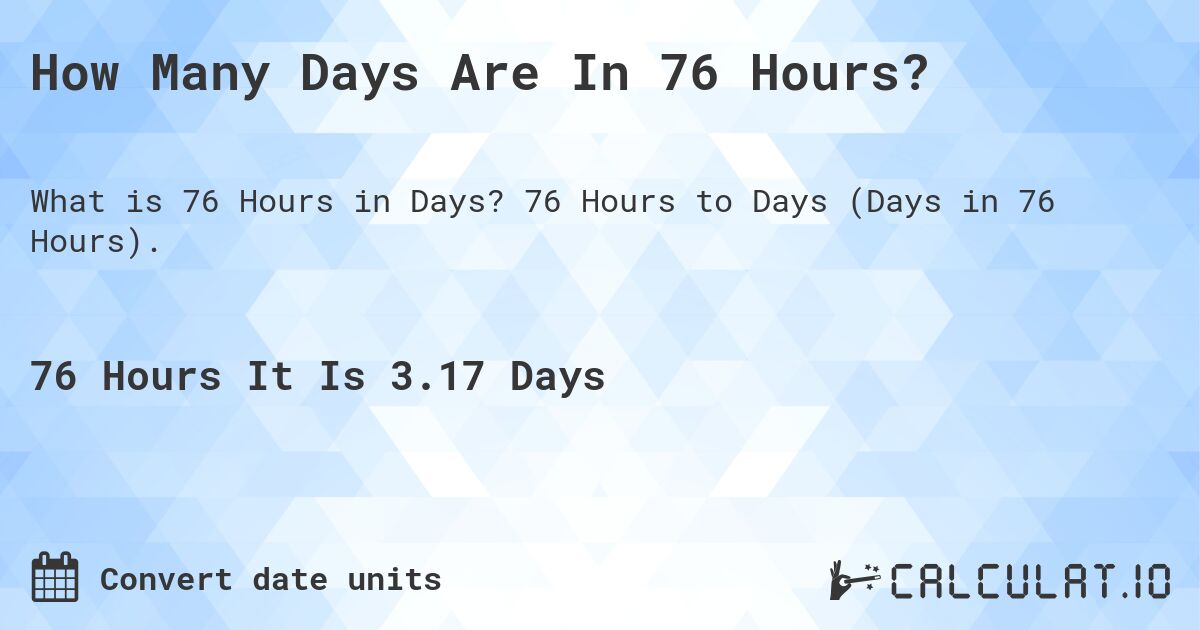Hours To Days: Conversions & Calculations Explained
How much time truly slips through our fingers each day? Time, a relentless river, flows ceaselessly, and understanding its measurement, especially the conversion of hours to days, is more crucial than we often realize.
The concept of time, and its measurement, has been a cornerstone of human civilization. From the sundials of ancient Egypt to the atomic clocks of today, our quest to quantify and control time has shaped our societies and our understanding of the universe. A day, for instance, is the approximate period it takes for the Earth to complete one rotation, and is a fundamental unit of time. But how do we translate smaller increments, like hours, into this larger, more easily grasped unit?
Let's delve into the mechanics of this conversion. The basic principle is simple: there are 24 hours in a day. Therefore, to convert hours to days, we divide the number of hours by 24. For instance:
- Explore Nsfw Games Tagged Strip On Itchio Discover Now
- Camilla Araujo Leaks Nude Videos Latest Updates
- 3 hours = 0.125 days
- 30 hours = 1.25 days
- 10000 hours = 416.67 days
- 4 hours = 0.1667 days
- 40 hours = 1.6667 days
- 25000 hours = 1041.67 days
- 5 hours = 0.2083 days
- 50 hours = 2.0833 days
- 50000 hours = 2083.33 days
- 6 hours = 0.25 days
- 100 hours = 4.1667 days
- 100000 hours = 4166.67 days
- 7 hours = 0.2917 days
- 250 hours = 10.4167 days
The inverse is equally straightforward. To convert days to hours, we multiply the number of days by 24. For example, 3.2 days would be equivalent to 3.2 days * 24 hours/day = 76.8 hours.
But what about converting decimal hours into the more familiar format of hours, minutes, and seconds? Let's take an example. To convert 2.88 hours to hh:mm:ss, we first recognize the 2 represents the whole hours. Then, 0.88 hours is converted to minutes by multiplying 0.88 by 60 (minutes in an hour), which equals 52.8 minutes. Finally, the 0.8 minutes are multiplied by 60 (seconds in a minute), resulting in 48 seconds. Therefore, 2.88 hours is equivalent to 2 hours, 52 minutes, and 48 seconds.
The second, in 1960, was redefined in terms of the orbital motion of the Earth in the year 1900. The second was designated as the SI base unit of time. The hour (h) is conventionally defined as 1/24th of a day and equal to 3,600 seconds. It is the SI unit of time. In coordinated universal time, a negative or positive leap second may be incorporated to keep the hour within 0.9 seconds of universal time. This can make an hour either 3,599 or 3,601 seconds in some cases. It is defined as exactly 86,400 seconds.
- A Cry For Help The Tracey Thurman Story Watch Now Learn
- Malia Kipp Remembering The Lady Griz Legend Her Legacy Latest News
For the sake of illustrating real-world applications, let's examine a hypothetical work scenario. Imagine an individual who wishes to work 76 hours per fortnight, spread over 9 days. This individual will work Monday to Friday, from 8:00 AM to 5:00 PM, with a 0.5-hour unpaid meal break each day. Considering the break, they will work 8.5 hours per day (9 hours - 0.5 hours). Therefore, over 9 days, they will work 76.5 hours (8.5 hours/day x 9 days). To align with their desired 76-hour fortnight, the person will finish work at 4:30 PM on the Friday of week ending 9/2/2024, and every other Friday after that.
Here's an example of how it will go. We can convert 76 hours to days by multiplying 76 by 0.041666666666667, because 1 hour is 0.041666666666667 days. The result is 76 hours x 0.041666666666667 = 3.167 days.
The world is filled with time-based figures. In 3 days and 4 hours, an estimate of 2,082,192 calls will be made to 911 emergency services. The amount of food eaten in that time also brings forth big numbers. It is estimated that 240 million calls to 911 US emergency services each year and, in 3 days and 4 hours, 4,771,690 Big Macs will be eaten in US McDonald's!
The following table will clarify the use of PTO (Paid Time Off) and other working-hour calculations:
| Scenario | PTO Hours | Working Hours Per Day | Calculation | Result | Explanation |
|---|---|---|---|---|---|
| PTO Usage | 40 | 8 | 40 / 8 | 5 days | You can take off 5 full days with 40 hours of PTO. |
| PTO Usage | 100 | 9 | 100 / 9 | 11.11 days | You can take off 11 full days with a few hours remaining (11.11 - 11 = 0.11). |



Detail Author:
- Name : Corene McDermott
- Username : hamill.leopoldo
- Email : leffler.wiley@schimmel.com
- Birthdate : 2006-08-26
- Address : 335 Gerlach Ports Jenkinsfort, OH 10084
- Phone : 813.327.2095
- Company : Schoen LLC
- Job : Continuous Mining Machine Operator
- Bio : Magnam deserunt omnis sit reprehenderit beatae. Modi qui odit facilis minus amet. Repudiandae et impedit in asperiores perferendis.
Socials
instagram:
- url : https://instagram.com/wellington_gaylord
- username : wellington_gaylord
- bio : Hic rerum soluta repellendus. Eius natus voluptas voluptas aut. At pariatur enim optio et animi.
- followers : 4567
- following : 588
linkedin:
- url : https://linkedin.com/in/gaylord1971
- username : gaylord1971
- bio : Ut sit eos odio.
- followers : 566
- following : 973
facebook:
- url : https://facebook.com/gaylordw
- username : gaylordw
- bio : Assumenda odit omnis reiciendis deserunt nam.
- followers : 3762
- following : 376